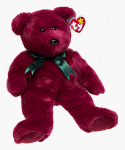Beanie Babies Beenie Beeny
Teddy The Cranberry Bear Beanie Buddy by Ty
 Here's a cranberry everyone will like. The tag on this gorgeously hued Beanie Buddy bear reads Teddy the Beanie Baby was made in six colors. A very limited number were produced in this special cranberry color! (The Beanie Buddy is a larger version of the Beanie Baby.) Around Teddy's neck, a forest green satin ribbon is tied in a bow; the face has plastic eyes and nose; and the paws are done in a shorter-napped fabric for contrast. The shell is made from 100 percent Tylon, a Ty Inc. exclusive manmade fabric that has the most luxurious feel you'll ever find on a plush toy. Teddy's insides are made of polyester fiber and PE pellets in a cloth bag. He makes a wonderful toy or addition to a collection. Surface wash only.
Here's a cranberry everyone will like. The tag on this gorgeously hued Beanie Buddy bear reads Teddy the Beanie Baby was made in six colors. A very limited number were produced in this special cranberry color! (The Beanie Buddy is a larger version of the Beanie Baby.) Around Teddy's neck, a forest green satin ribbon is tied in a bow; the face has plastic eyes and nose; and the paws are done in a shorter-napped fabric for contrast. The shell is made from 100 percent Tylon, a Ty Inc. exclusive manmade fabric that has the most luxurious feel you'll ever find on a plush toy. Teddy's insides are made of polyester fiber and PE pellets in a cloth bag. He makes a wonderful toy or addition to a collection. Surface wash only.
Beanie Babies as Collectibles
The world of collectibles has seen many trends, but few have garnered the international craze and economic phenomenon that was the Beanie Baby boom of the 1990s. Here's a brief overview of their ascent, peak, and legacy in the collectible world.
-
Beginnings:
- Beanie Babies were introduced by Ty Warner, the founder of Ty Inc., in 1993. They were distinguished by their unique, understuffed feel and the use of plastic pellet "beans" inside, giving them a flexible and realistic feel.
-
Marketing Genius:
- One of the remarkable aspects of Beanie Babies was Ty's marketing strategy. They were affordable, making them accessible to many. Limited production runs and periodic "retirements" of specific Beanie Babies created scarcity and drove demand. The "retired" toys often resurfaced in the secondary market at significantly inflated prices.
-
Collector's Frenzy:
- As their popularity grew, many started viewing Beanie Babies as investment opportunities. Collector's guides, conventions, and trade shows emerged. Some rare Beanie Babies fetched thousands of dollars, and collectors scrambled to predict which would be the next big hit.
-
The Bubble Bursts:
- In the late 1990s, the market began to saturate, and the Beanie Baby investment bubble started to burst. By the early 2000s, many of the Beanie Babies that once fetched exorbitant prices on the secondary market lost significant value.
-
End of an Era and Legacy:
- In 1999, Ty Inc. announced that they would cease production of Beanie Babies, creating a surge in demand. However, they resumed production shortly after due to public outcry. Though the craze has long since subsided, Beanie Babies still hold a special place in many people's hearts. They remain a symbol of 90s nostalgia and serve as a cautionary tale of speculative investing in the world of collectibles.
-
Digital Era:
- Beanie Babies have since ventured into the digital world. Ty introduced virtual Beanie Babies that came with codes for an online counterpart. These virtual toys allowed for online interactivity, showcasing the brand's adaptability to changing times and technologies.
Beanie Babies are a cultural phenomenon, representing both the whimsy of childhood and the complexities of economic speculation. Their history serves as a testament to the unpredictable nature of market trends and the power of clever marketing.
